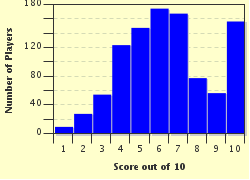Quiz Answer Key and Fun Facts
1. Ivan Pavlov is most famous for his demonstrations of classical conditioning. Which household pet did he use for his experiments?
2. Are pigeons smarter than humans? Well, research into the Monty Hall problem would suggest so! You are given three doors and select one. One of the wrong doors is then opened. You then have to choose one of the two remaining doors. What should you do?
3. Nikolaas Tinbergen developed the concept of supernormal stimuli. He constructed artificial objects to see how an animal changes its behaviour given a change in variables. One of these experiments involved giving a bird a choice of eggs to sit on. Which of the following eggs would the bird choose?
4. Edward Thorndike is known for his experiments with cats. He used our furry friends in order to develop his theories on how beings learn things. What was the name of the equipment that he used, in order to observe how an animal's behaviour changes over time?
5. Karl Von Frisch is famous for his studies on the behaviour of bees. He constructed a glass honeycomb so that he could observe the activities of the bees from all sides. Von Frisch was then able to determine that the bees could communicate the location of a food source by doing which complex dance?
6. The mirror test is used as a measure of self-awareness in animals. It involves the animal being marked in some way, and then being put in front of a mirror to see how it reacts. Which is the only bird that has been shown to conclusively pass the mirror test?
7. Wolfgang Kohler did a lot of work on problem solving abilities in animals. He was the director of a research station on Tenerife during World War I. Which animals did he set up a multitude of experiments for, in order to see how they would adapt to a testing situation?
8. One of the numerous inventions attributed to B.F. Skinner is the operant conditioning chamber. In one test, a rat was placed in the chamber, along with a button to press that would supply food pellets to a food tray. If the rat retrieved the pellet immediately, it would trigger a time penalty where no more pellets would be available. Instead, the rat could learn to repeatedly press the button, so that it could accumulate lots of pellets at once. What is this latter phenomenon known as?
9. I often wonder why everyone is so afraid of spiders. Let's be honest, what are they really going to do to you? Well, Mary Cover Jones demonstrated that some fears can be unconditioned. She gave a boy named Peter some of his favourite food in the presence of a terrifying beast. He learned to grow tolerant of the evil doer and eventually progressed to touching it. What was he so scared of?
10. Konrad Lorenz is often depicted as being followed by a group of young geese. He demonstrated that in the early hours of geese hatching from their eggs, they would latch on to the first moving thing that they saw. First discovered by Douglas Spalding, what is the name for this phenomenon?
Source: Author
ajwtimperley
This quiz was reviewed by FunTrivia editor
crisw before going online.
Any errors found in FunTrivia content are routinely corrected through our feedback system.

